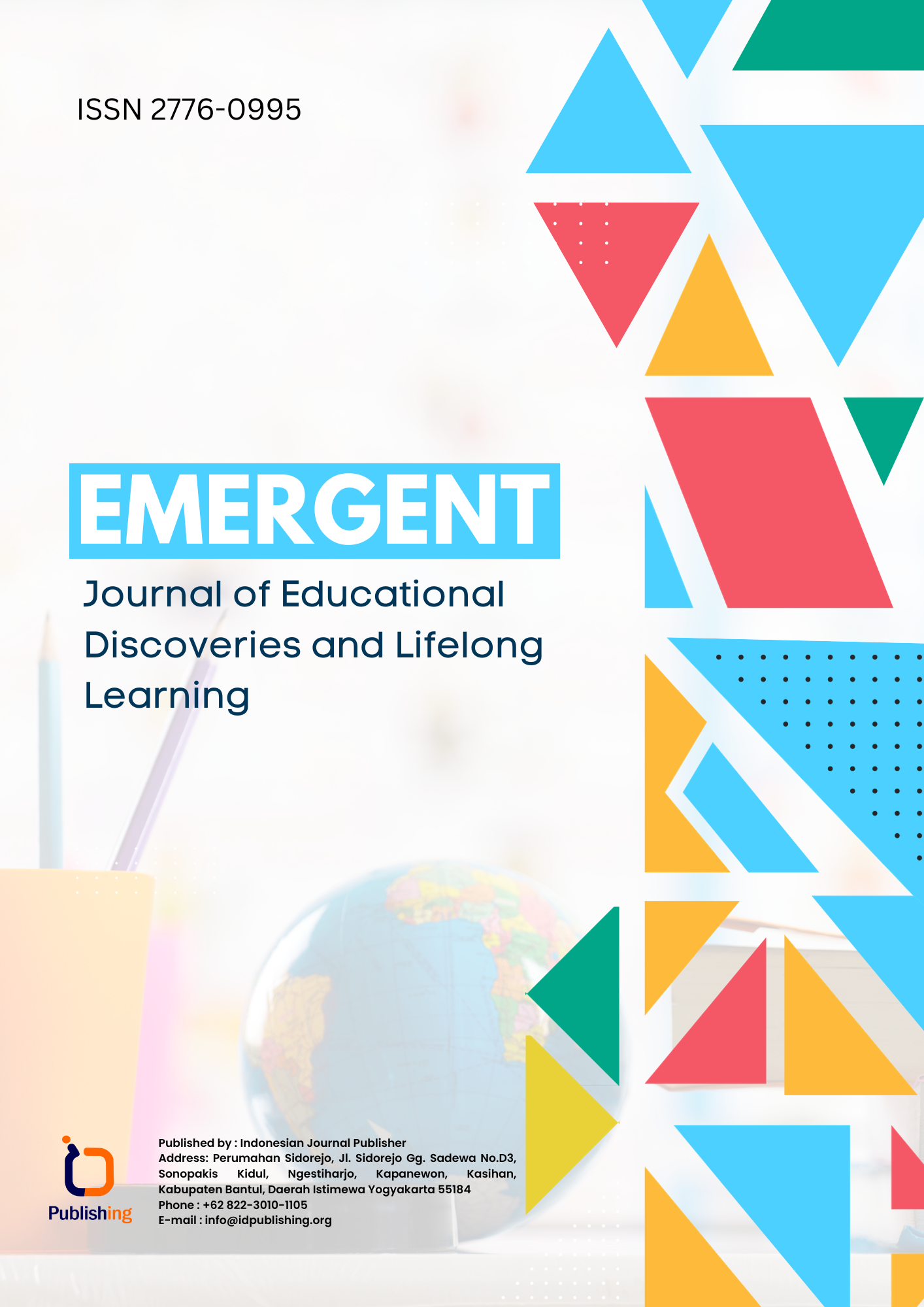Developing Students’ Spatial Imagination In Steam Education
DOI:
https://doi.org/10.47134/emergent.v3i4.49Keywords:
Imagination, STEAM Educational Technology, Spatial Imagination, Technology, Spatial Thinking, Creative TaskAbstract
This article discusses STEAM educational technologies and their use, the significance of using STEAM educational technologies in developing spatial imagination of primary school students as well as defines several definitions of the concept of imagination, and methods for developing students' spatial imagination.
References
Bertrand, M. G. (2020). STEAM education: student learning and transferable skills. Journal of Research in Innovative Teaching and Learning, 13(1), 43–56. https://doi.org/10.1108/JRIT-01-2020-0003 DOI: https://doi.org/10.1108/JRIT-01-2020-0003
Caiwei Zhu.//Foster spatial// Frontiers in Education 2023. 1-18 – b.
Choi, S. Y. (2021). The Impacts of a Climate Change SSI-STEAM Program on Junior High School Students’ Climate Literacy. Asia-Pacific Science Education, 7(1), 96–133. https://doi.org/10.1163/23641177-bja10019 DOI: https://doi.org/10.1163/23641177-bja10019
Chung, C. C. (2022). Using an iSTEAM project-based learning model for technology senior high school students: Design, development, and evaluation. International Journal of Technology and Design Education, 32(2), 905–941. https://doi.org/10.1007/s10798-020-09643-5 DOI: https://doi.org/10.1007/s10798-020-09643-5
Faulconer, E. K. (2020). Infusing Humanities in STEM Education: Student Opinions of Disciplinary Connections in an Introductory Chemistry Course. Journal of Science Education and Technology, 29(3), 340–345. https://doi.org/10.1007/s10956-020-09819-7 DOI: https://doi.org/10.1007/s10956-020-09819-7
Hau, N. H. (2020). Students and teachers’ perspective of the importance of arts in steam education in Vietnam. Journal of Critical Reviews, 7(11), 666–671. https://doi.org/10.31838/jcr.07.11.121
Khamhaengpol, A. (2021). Development of STEAM activity on nanotechnology to determine basic science process skills and engineering design process for high school students. Thinking Skills and Creativity, 39. https://doi.org/10.1016/j.tsc.2021.100796 DOI: https://doi.org/10.1016/j.tsc.2021.100796
Lindberg, L. (2020). STEAM Maker Education: Conceal/Reveal of Personal, Artistic and Computational Dimensions in High School Student Projects. Frontiers in Education, 5. https://doi.org/10.3389/feduc.2020.00051 DOI: https://doi.org/10.3389/feduc.2020.00051
Malele, V. (2020). The Design Thinking Approach to students STEAM projects. Procedia CIRP, 91, 230–236. https://doi.org/10.1016/j.procir.2020.03.100 DOI: https://doi.org/10.1016/j.procir.2020.03.100
M.X.Tashibekova //Boshlang‘ich sinflarda STEAM - talim texnologiyasidan foydalanish metodikasi(tabiiy fanlar misolida)//.P.f.b.f.d dis.N-2022.
Ortiz-Revilla, J. (2021). Effects of an integrated STEAM approach on the development of competence in primary education students (Efectos de una propuesta STEAM integrada en el desarrollo competencial del alumnado de Educación Primaria). Infancia y Aprendizaje, 44(4), 838–870. https://doi.org/10.1080/02103702.2021.1925473 DOI: https://doi.org/10.1080/02103702.2021.1925473
Ozkan, G. (2021). Investigating the effectiveness of STEAM education on students’ conceptual understanding of force and energy topics. Research in Science and Technological Education, 39(4), 441–460. https://doi.org/10.1080/02635143.2020.1769586 DOI: https://doi.org/10.1080/02635143.2020.1769586
O‘zbekiston Respublikasi Prezidentining 2019-yil 29-apreldagi “O‘zbekiston Respublikasi Xalq ta’limi tizimini 2030-yilgacha rivojlantirish konsepsiyasini tasdiqlash to‘g‘risida”gi PF-5712-son farmoni. Elektron resurs https://lex.uz/docs/4312785
Salas-Pilco, S. Z. (2022). Artificial Intelligence and New Technologies in Inclusive Education for Minority Students: A Systematic Review. Sustainability (Switzerland), 14(20). https://doi.org/10.3390/su142013572 DOI: https://doi.org/10.3390/su142013572
Sangirova Z. //Tabiiy fanlarni o‘qitishda STEAM ta’limidan foydalanish//.Science and innovation. International Scientific journal. UIF-2022 N.4, B – 345.
Shen, S. (2021). Teacher Suggestion Feedback Facilitates Creativity of Students in STEAM Education. Frontiers in Psychology, 12. https://doi.org/10.3389/fpsyg.2021.723171 DOI: https://doi.org/10.3389/fpsyg.2021.723171
So‘fiboyeva G Integratsiyalashgan STEM – ta’lim texnologiyasi asosida o‘quvchilarning fazoviy tasavvurlarini rivojlantirish metodikasi // “Ta’lim tizimida innovatsiya, integratsiya va zamonaviy pedagogik texnologiyalar” mavzusida xalqaro ilmiy-amaliy konferensiya materiallari (2024-yil 18 – 19-aprel) B – 183-186
Sofiboyeva G. The Content of Developing Students' Spatial Imaginations Through STEM // International Journal of Scientific Trends- (IJST)/ ISSN: 2980-4299 Volume 3, Issue 02, February, p-2024 33-35
Upadhyay, B. (2021). Steam Education for Critical Consciousness: Discourses of Liberation and Social Change Among Sixth-Grade Students. Asia-Pacific Science Education, 7(1), 64–95. https://doi.org/10.1163/23641177-bja10020 DOI: https://doi.org/10.1163/23641177-bja10020
Wilson, H. E. (2021). Effects of transdisciplinary STEAM lessons on student critical and creative thinking. Journal of Educational Research, 114(5), 445–457. https://doi.org/10.1080/00220671.2021.1975090 DOI: https://doi.org/10.1080/00220671.2021.1975090
Woodford, P. (2022). What are STEAM proponents thinking? on creativity, excellence, and measurement. Diálogos Sonoros, 1(1), 1-15.
Downloads
Published
How to Cite
Issue
Section
License
Copyright (c) 2024 Gulchehra Sofiboyeva

This work is licensed under a Creative Commons Attribution 4.0 International License.





